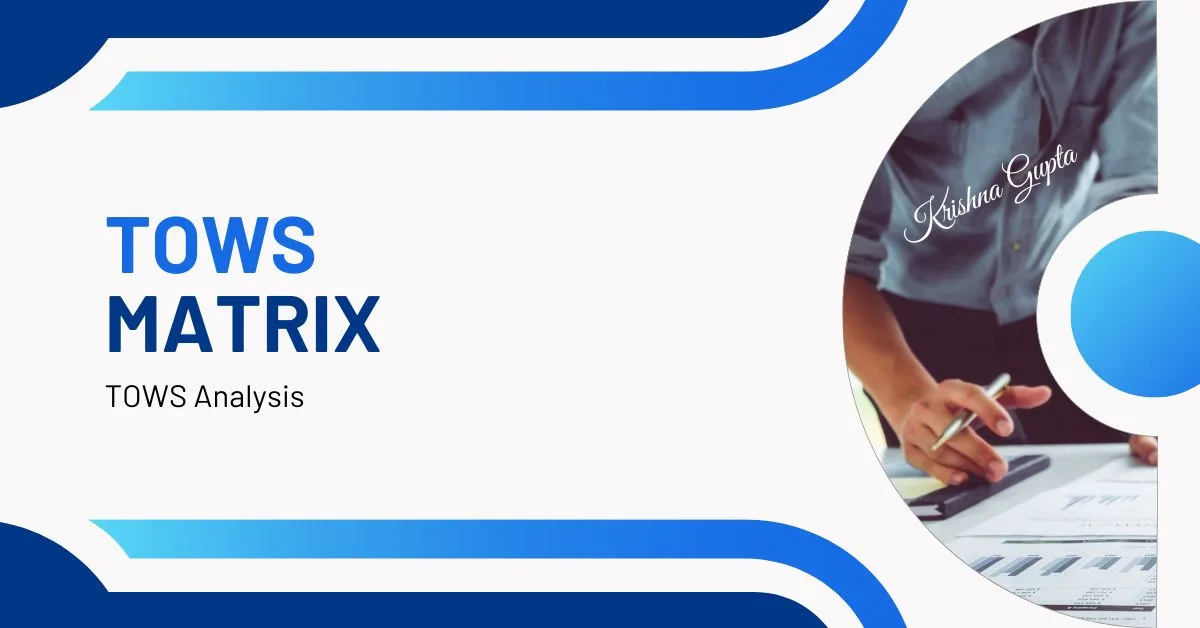Leveraging the TOWS Matrix for Strategic Growth in Indian MSMEs: A Comprehensive Guide
Strategic planning is imperative for sustained growth and success in the ever-changing and competitive business landscape, especially for India’s bootstrapped Micro, Small, and Medium Enterprises (MSMEs). Among the various strategic planning tools available, the TOWS Matrix stands out as an invaluable framework for assessing internal strengths and weaknesses vis-à-vis external opportunities and threats, thus aiding in formulating effective strategies. This article aims to delve into the intricacies of the TOWS Matrix and explore its advantages and disadvantages concerning Indian MSMEs.
Understanding the TOWS Matrix:
The TOWS Matrix, an acronym for Threats, Opportunities, Weaknesses, and Strengths, is a strategic planning tool that correlates internal strengths and weaknesses with external opportunities and threats. It comprises a 2×2 matrix that assists organisations in generating strategies that align their strengths with opportunities, overcome weaknesses to seize opportunities, mitigate weaknesses against threats, and leverage strengths to combat threats.
Advantages of TOWS Matrix for Indian MSMEs:
1. Strategic Insights:
- Example: An Indian MSME operating in the manufacturing sector might identify a strength in its skilled workforce and recognise an opportunity in the growing demand for eco-friendly products. The company could strategise to develop environmentally sustainable products through the TOWS Matrix, utilising its skilled workforce to capitalise on the market demand.
2. Holistic Analysis:
- Example: An MSME in the technology space may have a weakness in outdated infrastructure but recognises an opportunity in emerging technologies. By employing the TOWS Matrix, the company can develop a strategy to upgrade its infrastructure (mitigating the weakness) to venture into the burgeoning field of artificial intelligence or IoT (leveraging the opportunity).
3. Better Decision-making:
- Example: A service-oriented MSME in India might identify intense competition (threat) and a lack of diversified services (weakness). Through the TOWS Matrix, the company could focus on strategic collaborations or joint ventures (leveraging strength) to diversify its service offerings and counter the competitive threat.
Disadvantages of TOWS Matrix for Indian MSMEs:
1. Complexity and Resource Intensiveness:
- Indian MSMEs, often constrained by limited resources, may find conducting a comprehensive TOWS analysis time-consuming and resource-intensive.
2. Overemphasis on Analysis:
- Small-scale enterprises might get overly engrossed in the analysis phase without effectively implementing strategies, leading to paralysis by analysis.
3. External Factors’ Volatility:
- Rapidly changing market dynamics in India, including policy changes, economic fluctuations, or technological advancements, might render the identified opportunities or threats obsolete.
Conclusion:
The TOWS Matrix is a valuable strategic planning tool for Indian MSMEs, enabling a structured analysis of internal capabilities and external factors. It empowers these enterprises to craft informed strategies, capitalise on opportunities, and address weaknesses and threats effectively.
However, despite its limitations, MSMEs must exercise caution while utilising this tool. Flexibility and adaptability in strategy execution are crucial in navigating the ever-evolving business landscape in India. By leveraging the TOWS Matrix judiciously, Indian MSMEs can enhance their competitiveness and foster sustainable growth in the dynamic market scenario.
In essence, the TOWS Matrix isn’t a panacea for success but rather a guiding compass that, when used astutely, can steer Indian MSMEs towards strategic excellence in a highly competitive environment.
The TOWS Matrix, sometimes referred to as TOWS Analysis, is strategic planning used to examine and analyse the relationship between an organisation’s internal strengths and weaknesses, mapping the external opportunities and threats it faces. It helps generate strategic options and identify strategies that align with the organisation’s objectives. The name “TOWS” is an acronym derived from the critical elements of the matrix: Threats, Opportunities, Weaknesses, and Strengths.

Here’s how the TOWS Matrix is structured:
- Strengths (S): These internal factors give an organisation an advantage over others in its industry. They could include a strong brand, skilled workforce, advanced technology, or efficient processes.
- Weaknesses (W): These internal factors place an organisation at a disadvantage compared to others. They could involve poor leadership, inadequate resources, outdated technology, or inefficient processes.
- Opportunities (O): These are external environmental factors that the organisation could exploit to its advantage. Opportunities might arise from market trends, technological advancements, regulation changes, or new consumer behaviours.
- Threats (T): These external factors could negatively impact the organisation’s performance. Threats may come from competitors, regulation changes, economic downturns, or technological disruptions.
By combining these factors, the TOWS Matrix generates strategies that help leverage strengths to exploit opportunities (SO strategies), use strengths to counteract threats (ST strategies), minimise weaknesses by taking advantage of opportunities (WO strategies), and overcome weaknesses to avoid threats (WT strategies).
Here’s an overview of the four types of strategies in the TOWS Matrix:
- SO Strategies (Strengths-Opportunities) involve using an organisation’s strengths to take advantage of external opportunities, such as leveraging a solid brand and skilled workforce to enter a new market.
- ST Strategies (Strengths-Threats): These strategies use an organisation’s strengths to mitigate or counter external threats. For instance, they use technological superiority to outpace competitors or diversify products/services to reduce dependency on a single market.
- WO Strategies (Weaknesses-Opportunities): These strategies focus on overcoming internal weaknesses by exploiting external opportunities and investing in training and development to address skill gaps and take advantage of emerging market trends.
- WT Strategies (Weaknesses-Threats): These strategies involve defensive measures to minimise weaknesses and avoid threats. This might include strategic partnerships to compensate for resource limitations or downsizing to mitigate the impact of an economic downturn.
The TOWS Matrix is a framework for strategic analysis and decision-making, helping organisations develop robust strategies that correlate with their internal capabilities and external environment.